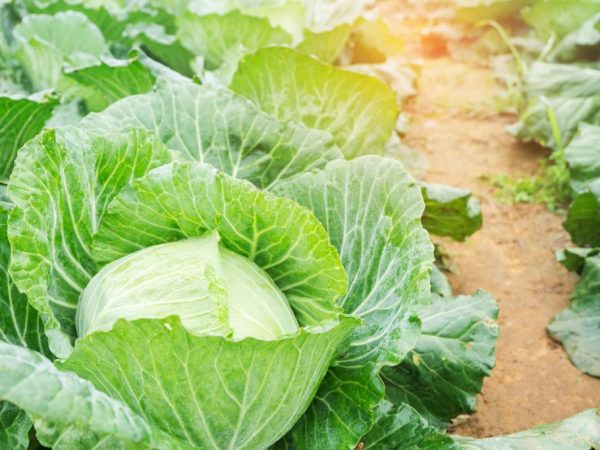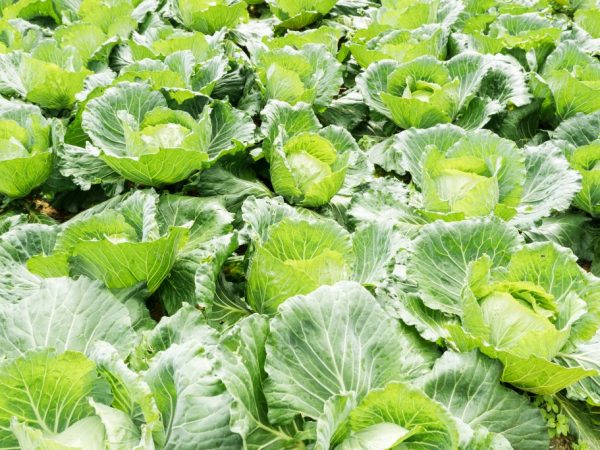Cabbage variety Miracle on Record
Among the variety of varieties, Miracle cabbage occupies a leading position on Record F1. The vegetable has combined the best features of the parent plants. In 2016, he took a leading position and was massively grown in fields and summer cottages.

Cabbage variety Miracle on Record
Characteristics of the variety
White cabbage Miracle on Record f1 is a late-ripening hybrid from Dutch breeders. It is frost-resistant and easily tolerates nighttime temperature drops.
Cabbage is grown in two ways: seedling and seedling, however, for this variety, it is recommended to plant seeds directly into the soil.
The variety has a high watering requirement. Lack of moisture inhibits fork formation.
Description of the head
With good care, large dense heads of cabbage weighing up to 7 kg are tied. When ripe, they do not crack on the stem. Sometimes the size of the fork is too large and the stem cannot withstand such a load. In this case, the plant needs support.
The head of the cabbage Miracle on the Record is flat-round. Leaves are thin, well adhering to the stalk, light green.
Application and storage
Hybrid Miracle on Record f1 has excellent taste characteristics. This allows the vegetable to be used for cooking:
- traditional first courses: borscht, cabbage soup;
- salting for the winter;
- sauerkraut;
- second courses: casseroles, hot salads and snacks;
- fresh salads;
- fillings for pies, pies and dumplings.
Cabbage is stored until mid-winter without loss of taste and presentation. After that, the stump and upper leaves begin to rot. The vegetable is used first. The storage of cabbage forks should be dry and cool. Most often it is placed in basements on wooden or plastic shelves.
The shelf life is significantly reduced if the plant is watered later than 2 weeks before harvest. The head of cabbage cracks and rots quickly.
The variety is rich in vitamin C. Only 200-250 g of fresh shredded cabbage contains a daily dose of ascorbic acid. When heat treated, the vegetable loses these properties.
Care
Planting seeds
The hybrid is able to fully develop in open ground conditions. This greatly simplifies the process of planting and caring for seedlings.
The seeds are planted in March or early April. It is advisable to create a greenhouse effect for the plant, since in early spring there are sharp changes in temperature, which is detrimental to cabbage.
The distance between the holes should be at least 60 x 60 cm, taking into account the expectation of a large harvest. The depth for the seed is about 0.5-1 cm. The first shoots appear in a week.
Top dressing

Top dressing will increase the productivity of plants
During the growing season and active formation of the head of cabbage, the plant is fed. The lack of organic and mineral components in the soil leads to a halt in the growth and development of the bush.
To obtain an environmentally friendly harvest, cabbage is fed with mullein infusion, wood ash and weed infusion. Fertilizing cabbage beds with eggshells has also shown itself to be good.The decision to use mineral fertilizing of chemical origin is taken by the gardeners themselves. This affects the quality of the finished product.
More Tips
The variety is grown in low acid soil. Otherwise, it is advised to pour lime in the aisle to get rid of the problem. It is noticed that the soil after such treatment becomes looser and more fertile, it passes moisture well.
If several seeds were placed in the holes and all sprouted, the weak ones are removed, leaving one strong sprout. You cannot pull out the plant by the root: this increases the risk of damaging the rest of the seedlings. It is better to take scissors and carefully cut off unnecessary shoots at the root.
In the case of planting seedlings in a common container, the plant is transplanted for 35-40 days. It is important not to overgrow the cabbage. At this point, 4-5 real leaves should already appear. The time for transplanting into open ground is mid or late May.
Pests
The following insects harm cabbage:
- Cabbage aphid. When it appears, dark dots appear, the leaves curl up. It is more often seen on young plants.
- Cabbage bug. The affected area turns yellow. The pest attacks the ovaries.
- Garden scoop. There are 2 types of this insect. One affects the upper part - the leaves, and the second - the roots. Actively attacks the plant at night.
- Slug. The pest loves the night time.
- Dark nutcracker. Prefers moisture and acidic environment. Chalk, lime and ash are used against the pest.
- An ordinary bear. Gnaws cabbage leaves, especially young ones.
- Cabbage root lurker. It affects the pulp, moving to the roots.
- Cabbage scoop. Afraid of spraying with hot pepper decoction.
- Cabbage moth. A butterfly laying eggs on the inside of a leaf. If not removed, caterpillars will appear in a month.
Pest control
Cabbage leaves are powdered with wood ash. For 1 sq. m use 1 tbsp. ash. The leaves are often examined from both the inside and the outside.
Ash is also scattered in the aisles. This not only serves as a fertilizer for the soil, but also prevents slugs and grape snails from entering the garden. For the same purpose, distracting baits are made. Not far from the plantings, pieces of cucumber or young zucchini are laid out. Slugs slide there, after which they are manually removed from the site.
Spraying almost ripe heads of cabbage with a solution of laundry soap also helps. To do this, rub it on a fine grater or grind it in a blender. Soap powder will dissolve faster in water. The solution is white, almost milky in color. Forks are sprayed or washed with a washcloth soaked in solution.
Diseases
The plant rarely suffers from major cabbage diseases, since the hybrid is immune to them. Still, black leg infection does occur. Gray bacterial rot appears due to over-watering or prolonged rains.
Prevention of cruciferous disease consists in compliance with the requirements of agricultural technology of a particular variety. If the soil on the site has a high percentage of clay impurities and does not allow water to pass through, drainage drainage channels are made. They remove excess moisture from the site and allow the cabbage to grow well.
Conclusion
Cabbage Miracle on Record f1 is useful in many ways. It is a source of folic acid, which is especially important for women during pregnancy. The possibility of its storage in the autumn-winter period guarantees the availability of vitamin salads on the table until mid-winter.
The quality of the heads of cabbage in technical maturity allows them to be transported without losing their presentation, therefore the variety is grown on an industrial scale and supplied to shops, markets and grocery stores.


